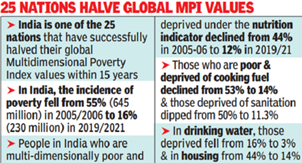

Context
The latest update of the global Multidimensional Poverty Index (MPI) with estimates for 110 countries was released recently. It revealed that 25 countries successfully halved their global MPI values within 15 years (including India), showing that rapid progress is attainable.
Basics of Multidimensional Poverty Index (MPI)
- The global Multidimensional Poverty Index is used to measure acute multidimensional poverty in developing countries.
- Indicators: It monitors 10 indicators including health, education, and standard of living and “it also includes both incidences as well as the intensity of poverty.”
- Released by: The Index is released by the United Nations Development Programme (UNDP) and the Oxford Poverty and Human Development Initiative (OPHI) at the University of Oxford.
- The latest update of the global Multidimensional Poverty Index (MPI) with estimates for 110 countries
What is Poverty?
- Poverty entails more than the lack of income and productive resources to ensure sustainable livelihoods. People living on less than USD 1.90 a day typically is considered to be in poverty.
- Multidimensional poverty encompasses the various deprivations experienced by poor people in their daily lives – such as poor health, lack of education, inadequate living standards, disempowerment, poor quality of work, the threat of violence, and living in areas that are environmentally hazardous, among others.
- Multidimensionally poor: An individual who is deprived of one-third or more of the weighted indicators is multidimensionally poor.
- Extreme multidimensional poverty: While any person deprived of one-half or more of the weighted indicators would fall into extreme multidimensional poverty.
|
Determination of poverty status in India Officially, a person who lives on a monthly expenditure of Rs 1,000 or less in cities and Rs 816 or less in villages, at 2011-12 prices is poor, per the poverty line determined by an Expert Group (Tendulkar) in that year. |
Key-findings of the 2023 Index
- The analysis of trends from 2000 to 2022, focused on 81 countries, according to the report, revealed that 25 countries successfully halved their global MPI values within 15 years.
- These include Cambodia, China, Congo, Honduras, India, Indonesia, Morocco, Serbia, and Viet Nam.

- These include Cambodia, China, Congo, Honduras, India, Indonesia, Morocco, Serbia, and Viet Nam.
- Acute multidimensional poverty:1 billion out of 6.1 billion people (just over 18 per cent) live in acute multidimensional poverty across 110 countries. Sub-Saharan Africa (534 million) and South Asia (389 million) are home to approximately five out of every six poor people.
- Poverty rate among children: Children under the age of 18 account for half of MPI-poor people (566 million). The poverty rate among children is 27.7 per cent, while among adults, it is 13.4 per cent.
- Poverty in middle-income countries: Nearly two-thirds of all poor people (730 million people) live in middle-income countries, making action in these countries vital for reducing global poverty.
- Poverty in low-income countries: Although low-income countries constitute only 10 per cent of the population included in the MPI, these are where 35 per cent of all poor people reside.
- Poverty in rural areas: Poverty predominantly affects rural areas, with 84 per cent of all poor people living in rural areas. Rural areas are poorer than urban areas across all regions of the world.
- India’s Story:
|
The Sustainable Development Goal target 1.2 is for countries to reduce at least by half the proportion of men, women, and children of all ages living in poverty in all its dimensions by 2030. India’s progress shows that this goal is feasible, even at scale. |
- A total of 415 million people in India came out of poverty within a span of just 15 years from 2005/2006 to 2019/ 2021.
- Poverty fell from 55.1% in 2005/06 to 16.4% in 2019/21 in India.
- In April, India surpassed China to become the world’s most populous nation with 142.86 crore people.
- Besides India, China lifted 69 million out of poverty between 2010-2014, and Indonesia 8 million between 2012-2017.
- In neighbouring Bangladesh and Pakistan, 19 million and 7 million individuals came out of poverty during 2015-2019 and 2012-2018, respectively.
Poverty alleviating schemes
- The Mahatma Gandhi National Rural Employment Guarantee Act 2005 (MNREGA)
- National Rural Livelihood Mission (NRLM)
- Pradhan Mantri Awaas Yojana-Gramin (PMAY-G)
- Public Distribution System (PDS)
- Housing for All
- Atal Mission for Urban Rejuvenation and Transformation (AMRUT)
|
October 17 is observed as the International Day for the Eradication of Poverty |
- Smart Cities Mission
- Digital India
- Jan Dhan Yojana
- Make in India
Conclusion
The MPI sheds light on the complexity of poverty – where different indicators contribute to people's experience of poverty differently, varying from region to subnational region, and between and within communities. Ensuring that the data on global poverty is up-to-date and comprehensive is a crucial first step in addressing these challenges and maintaining progress towards a more equal world.



